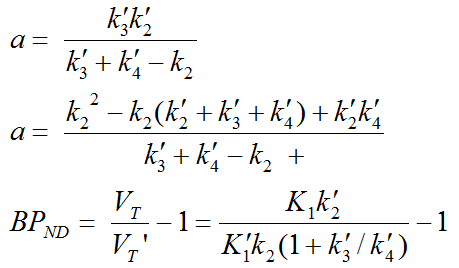Model Configuration and Assumptions
The 2 Tissue Reference Tissue method proposed by of Watabe [1] has been developed for ligands which do not follow the usual assumptions of the reference tissue models. Instead of a 1-tissue compartment model, the reference tissue is described by a 2-tissue model as illustrated below. The second compartment C2' may represent specific or non-specific binding.

Operational Model Curve
Assuming that the non-specific distribution volume of both tissues is the same, the following operational equation for fitting the tissue TAC can be derived (see Millet et al [2], appendix C):

When the parameters k2', k3', and k4' are fixed to constants determined with receptor-rich tissue, only R1 and k2 need to be fitted for estimating the binding potential BPND. The equation parameters and their relation to the model are given by:

For convolution with the exponentials, the reference tissue TAC CT'(t) is resampled on a regular grid, which can be specified by the Resampling parameter.
Parameter Fitting
After switching to the 2 Tissue Reference Model a suitable reference region must be selected. The operational equation includes six fitting parameters: R1, k2, k2', k3', k4'. Per default, the fit boxes of k2', k3' and k4' are off with the idea, that the values are determined externally. However, any of them may also be fitted. Fitting is performed using nonlinear techniques, and the main outcome is BPnd.
References
1.Original abstract: Watabe, H et al. The reference tissue model: Three compartments for the reference region. Neuroimage 11: S12.
2.Model description in Appendix C: Millet P, Graf C, Buck A, Walder B, Ibanez V: Evaluation of the reference tissue models for PET and SPECT benzodiazepine binding parameters. Neuroimage 2002, 17(2):928-942. DOI